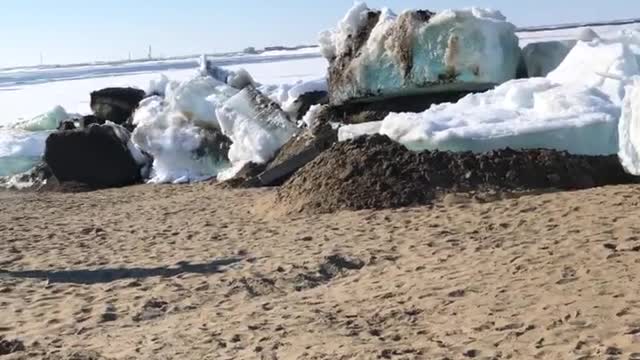Premium Only Content

Ice Tsunami Comes Crashing In
Ice tsunami in the extreme north of Russia means summer is to finish here. This video shows ice is dramatically moving and climbing ups the shore, with large chunks of the heavy floe crashing over the sand and rocks. Several residents of Dudinka still dressed in their warm clothes, retreat as they realize just how powerful the might of Yenisei is breaking its ice shield. Krasnoyarsk Ministry of Emergencies said that the video showed the first stage of the ice breaking, and that the river will get clear within about a week from the moment this footage was filmed.
When the ice crawls up out of the water and goes on a murderous rampage beside your house and family. Maybe the ice isn’t actively seeking demolition and mayhem when it comes on land in a phenomenon known as an ice shove. Ice shoves occur when solid winds or currents force the ice from the water’s surface to go on land. These events are also termed “ice tsunamis” because of the way they come on land, but ice shoves are closer to icebergs than tsunamis in how they work. The force from the ice shove can be powerful sufficient to knock over trees, houses, and docks that stand in its way.
Ice shoves occur when strong winds or currents force the ice from the water's surface to go on land or temperature differences pushing ice onto the shore, creating piles up to 12 meters (40 feet) high. About 80% of tsunamis occur within the Pacific Ocean's “Ring of Fire.” The first wave of a tsunami is generally not the strongest, successive waves get bigger and stronger. Tsunamis can travel at speeds of about 450 miles or 785 kilometers an hour, almost as fast as a jet plane. Witnesses have defined the shove's sound as being like that of a train or thunder.
Ocean water freezes just like freshwater, but at lesser temperatures. Fresh water freezes at 31 degrees Fahrenheit but seawater freezes at about 28.5 degrees Fahrenheit, because of the salt in it. At least 14 percent of the ocean is covered by sea ice some part of the year. Water is an unusual substance. When water freezes, it gets less dense. That is why ice dices float in a glass of water. It also takes a lot of energy removal to freeze water, and the air is typically much colder than the earth at the bottom of the lake. So a lot of things root the lake to freeze only on top.
-
 0:22
0:22
ViralHog
3 years ago $0.03 earnedCeiling Comes Crashing Down
27010 -
 0:14
0:14
ViralHog
3 years ago $0.03 earnedTonga Volcano Tsunami Sends Crashing Waves to California
3342 -
 1:06
1:06
ViralHog
3 years agoString of Christmas Lights Comes Crashing Down
131 -
 0:14
0:14
ViralHog
3 years ago $0.01 earnedGate Comes Crashing Down Onto Motorcycle
3413 -
 0:37
0:37
ViralHog
4 years ago $0.01 earnedCamera Installation Comes Crashing Down
1371 -
 23:31
23:31
IsaacButterfield
17 hours ago $0.06 earnedThe Woke Mob Is Really CANCELLING Matt Rife For THIS…
19.7K16 -
 1:23
1:23
WildCreatures
8 days ago $0.98 earnedThis mother armadillo eating her palm nuts is truly adorable
17.1K16 -
 8:59
8:59
The Art of Improvement
12 hours ago $0.02 earnedHow to Build the Most Powerful Mindset for Success
15.1K2 -
 1:26:16
1:26:16
Michael Franzese
21 hours agoMenendez Brothers Denied Parole – Newsom Holds Their Fate
120K94 -
 2:36:02
2:36:02
I_Came_With_Fire_Podcast
20 hours agoSecret Origins of Transhumanism & The New Atlantis
40.3K20